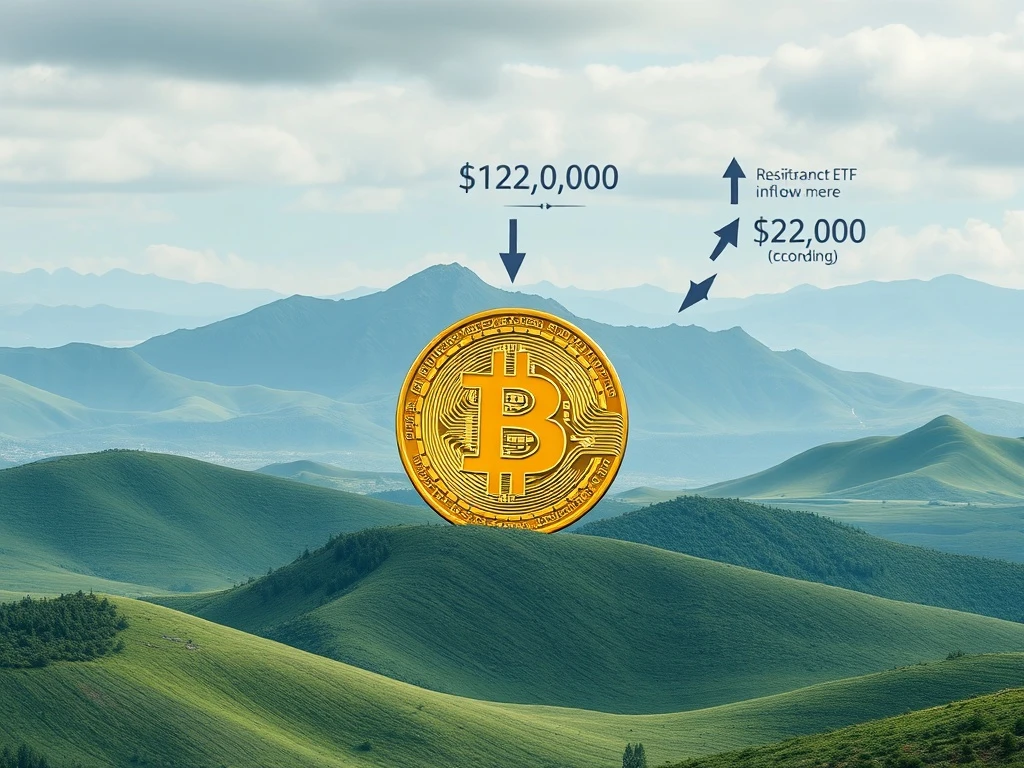Bitcoin Price: Crucial $122K Resistance Unveiled Amidst Surging ETF Inflows

The crypto world is abuzz as the Bitcoin Price continues its intriguing dance below the $120,000 mark. After a remarkable surge, the flagship cryptocurrency has settled into a consolidation phase, sparking intense debate among analysts and investors alike. Is this a healthy pause before another monumental ascent, or a warning sign of a potential downturn? The answer, as always, lies in dissecting the myriad of on-chain data, institutional movements, and technical indicators. With nearly $20 billion in ETF inflows painting a picture of robust institutional demand, the stakes couldn’t be higher for the future trajectory of the entire Crypto Market.
Understanding Bitcoin’s Current Consolidation Phase
Since mid-July, Bitcoin has largely remained consolidated, trading within a tight range, specifically between $117,422 and $119,197 over the past 24 hours. At the time of this writing, the Bitcoin Price hovers around $118,578. This period of stability, rather than extreme volatility, signals a transitional market phase marked by cautious investor behavior. It’s a moment where both bulls and bears are holding their breath, awaiting a definitive catalyst.
On-chain indicators provide crucial insights into this cautious sentiment:
- Index Bitcoin Cycle Indicators (IBCI): CryptoQuant contributor Gaah points out that Bitcoin’s IBCI has re-entered the “Distribution” zone. Historically, this zone is associated with late-stage bull markets, often preceding a bearish shift. However, the current level—80% of the zone’s upper boundary—suggests moderate expansion rather than full saturation.
- Puell Multiple & Short-Term Holder SOPR (STH-SOPR): Key components like these remain below their midpoints. This indicates a lack of widespread speculative fervor, reinforcing the idea that Bitcoin is in an expansionary phase without typical signs of overheating. It suggests that recent gains are not solely driven by FOMO (Fear Of Missing Out) but by more fundamental factors.
- Realized Cost of Short-Term Holders: Amr Taha of CryptoQuant notes that Bitcoin’s price stability near $118,300 aligns closely with the realized cost of short-term holders. This level acts as a dynamic support, representing the average cost basis for recent buyers. The fact that newer investors are not capitulating (selling at a loss) at this level underscores their confidence in the current price range, which serves as both a technical and psychological support zone.
Collectively, these signals paint a picture of a measured market expansion, where underlying fundamentals, rather than speculative trading, are driving momentum. This nuanced view is essential for anyone following Bitcoin News closely.
The Impact of Surging ETF Inflows on the Crypto Market
One of the most significant narratives shaping the current Crypto Market is the unprecedented institutional adoption, primarily through Spot Bitcoin ETFs. Year-to-date, these ETFs have attracted nearly $20 billion in capital, signaling sustained and robust institutional demand. This massive influx of capital acts as a powerful demand driver, underpinning Bitcoin’s resilience even during consolidation periods.
Why are these ETF Inflows so important?
- Legitimization and Accessibility: ETFs provide a regulated and familiar investment vehicle for traditional financial institutions and retail investors who might be hesitant to directly hold cryptocurrencies. This broadens Bitcoin’s investor base significantly.
- Price Support: Consistent inflows absorb selling pressure and create a strong demand floor for Bitcoin, making deep corrections less likely in the short to medium term.
- Market Maturation: The success of Bitcoin ETFs paves the way for other crypto-related financial products, as evidenced by the recent launch and impressive performance of new Spot Ethereum ETFs, which attracted $1.5 billion in just a week. This signifies a broader maturation of the crypto asset class within traditional finance.
Despite the strong inflows, trading volume has been muted, and liquidity metrics remain flat, suggesting that many traders are awaiting a clear catalyst. This calm before the storm underscores the importance of monitoring key price levels.
Navigating Key Resistance Levels: What’s Next for Bitcoin Price?
The immediate future of the Bitcoin Price hinges on its ability to overcome critical Resistance Levels. Analysts are particularly focused on the $122,000 threshold. Structural models based on Power Law resistance suggest that breaking above this level could be a significant turning point, potentially catalyzing further gains and validating bullish narratives.
However, failure to breach this resistance might extend the current consolidation phase, or worse, trigger a retest of lower support levels. The market is currently balanced on a knife-edge, with technical setups dictating the immediate trajectory.
Analyst Perspectives: A Divided Outlook
The professional analytical community remains divided on the near-term outlook for Bitcoin, reflecting the inherent uncertainties of the market:
- Cautious Warnings: Gaah, while acknowledging positive institutional adoption, warns of a high-risk correction zone. He emphasizes the need for close monitoring of retail behavior and miner activity, as these groups can significantly influence short-term price movements.
- Healthy Expansion: In contrast, top analyst Axel Adler maintains that Bitcoin is in a “healthy expansion phase” within the Bitcoin Investor Price Model, largely due to the sustained strength of ETF inflows. His view suggests that the current consolidation is a natural part of a larger upward trend.
- Long-Term Ambitions: Wall Street veteran Tom Lee, known for his bullish predictions, projects a staggering $3 million target for Bitcoin over decades, while maintaining a more immediate goal of $250,000 for 2025.
- Shorter-Term Rally: The Brave New Coin team anticipates a rally to $200,000 in the shorter term, contingent on sustained consolidation and continued ETF-driven demand.
These divergences highlight the broader tensions between macroeconomic caution and speculative optimism. Technical indicators like RSI (Relative Strength Index) and MACD (Moving Average Convergence Divergence) currently remain neutral, while Bollinger Bands are narrowing, signaling balanced buyer-seller dynamics—a classic setup for a potential breakout in either direction.
Macroeconomic Headwinds and Altcoin Performance
Beyond the internal dynamics of the Crypto Market, broader macroeconomic factors are also at play. Declining U.S. bond yields and the Federal Reserve’s cautious policy stance add layers of uncertainty to the outlook. These external forces can influence investor risk appetite, potentially diverting capital flows or intensifying market volatility.
Meanwhile, altcoins exhibit mixed performance, indicating a degree of sector rotation rather than systemic weakness:
- Solana (SOL) has shown resilience with a 5.1% gain, suggesting that some capital is flowing into specific altcoin narratives.
- In contrast, major altcoins like XRP and Dogecoin (DOGE) have experienced declines, reflecting a more selective approach by investors.
This mixed performance underscores that while Bitcoin remains the market’s anchor, the broader crypto ecosystem is not uniformly moving in one direction. Investors are becoming increasingly discerning, seeking out projects with strong fundamentals or clear catalysts.
What Does This Mean for the Future of Bitcoin?
The current consolidation below $120,000 is a critical juncture for Bitcoin. The market’s next significant move hinges on breaking key thresholds. A sustained close above $122,000 could decisively validate bullish narratives, potentially propelling the Bitcoin Price towards new all-time highs and fulfilling the more optimistic predictions.
Conversely, a sustained drop below $117,500 might reignite bearish sentiment, leading to a deeper correction. Analysts remain split between viewing the current consolidation as a temporary pause for accumulation or a topping pattern preceding a more significant downturn. For now, the crypto market balances on a knife edge, with the robust flow of ETF Inflows and the integrity of key technical setups dictating the immediate trajectory.
Staying informed with the latest Bitcoin News, understanding on-chain metrics, and tracking institutional activity will be paramount for navigating this complex yet potentially rewarding phase of the market. The coming weeks will likely reveal whether Bitcoin is poised for another historic surge or a period of prolonged re-evaluation.
Frequently Asked Questions (FAQs)
Q1: Why is Bitcoin consolidating below $120,000?
Bitcoin is consolidating due to a transitional market phase marked by cautious investor behavior. On-chain indicators like the IBCI and STH-SOPR suggest moderate expansion without overheating, while the price aligns with the realized cost of short-term holders, acting as a stable support level.
Q2: How are ETF inflows impacting the Bitcoin Price?
Spot Bitcoin ETFs have attracted nearly $20 billion in capital year-to-date, signaling strong institutional demand. These inflows provide significant price support, broaden Bitcoin’s investor base, and contribute to the overall maturation of the crypto market within traditional finance.
Q3: What are the key Resistance Levels for Bitcoin to watch?
The crucial resistance level for Bitcoin is $122,000. Breaking above this threshold could catalyze further gains, while failure to do so might extend consolidation or lead to a retest of lower support levels.
Q4: Are analysts bullish or bearish on Bitcoin’s near-term outlook?
Analysts are divided. Some, like Gaah, warn of a high-risk correction zone, urging caution. Others, like Axel Adler, view the current phase as a ‘healthy expansion’ due to strong ETF inflows. Long-term forecasts also vary widely, from $200,000 to $3 million targets.
Q5: How do macroeconomic factors affect the Crypto Market?
Macroeconomic factors such as declining U.S. bond yields and cautious Federal Reserve policy introduce uncertainty. These external forces can influence overall investor risk appetite, potentially impacting capital flows into the crypto market and contributing to volatility.
Q6: What does the mixed altcoin performance signify?
The mixed performance of altcoins, with some gaining (like Solana) and others declining (like XRP and Dogecoin), suggests sector rotation rather than systemic weakness. This indicates that investors are becoming more selective, focusing on specific projects or narratives within the broader crypto ecosystem.








